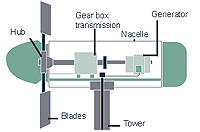Renewable Energy Technologies
(RETs) have become multi-billion dollar industry
from the realm of laboratories in recent years.
At present, most of the large International Oil
Companies (IOCs) have started serious business with
renewables, like Shell and British Petroleum have
individually committed US$500 million for renewable
energy investment. Installed capacity of non-hydro
RETs is already 60,000 MW [GEF 2001] and at present
they are supplying 14 percent of the total global
energy demand [WEA 2000]. The World Energy Council
(WEC), Shell, the Intergovernmental Panel on Climate
Change (IPCC) and several UN bodies expect a significant
share of RETs in the future with major contribution
from biomass, hydro, wind and solar energy (Mazharul
Islam, Bangladesh).
The global wind energy potential, even excluding
environmentally sensitive areas, is roughly
five times current global electricity use.
(CANWEA)
Anyone who has struggled
to stay upright in a strong gale is aware of
the intrinsic power of the wind. Indeed wind
energy has been harnessed by people for centuries.
The wind-mills with cloth sails used in many
European countries are a good example, as are
the multi-bladed windmills commonly seen on
farms and in rural areas of Australia. The power
of the wind is also used to propel sailing ships,
cool homes on balmy NSW summer evenings, and
fly kites. Recent research and development in
harnessing the wind means that we can now generate
electricity using wind energy. Modern machines
that generate electricity from the wind work
in much the same way as the more familiar European
windmills of old. These modern machines are
called wind turbines, as they produce electricity.
What is a wind turbine and how does it work?
 A
wind turbine is comprised of a tower, topped
by an enclosure called a nacelle, and the rotor,
which is the propeller-like structure connected
to the nacelle. The nacelle houses an electrical
generator, power control equipment and other
mechanical equipment, which is connected to
the rotor. The rotor blades are made out of
light composite materials such as fibreglass.
They are well researched and shaped to maximise
the energy harnessed. The wind strikes these
blades, and due to their shape, the wind causes
the rotor to spin. When the wind is strong enough,
the rotational energy in the rotor is converted
to electrical energy within the generator. Towers
are commonly made of steel tubes, although some
earlier models used steel lattices. The height
of the tower varies from turbine to turbine,
and is determined by the length of the blades,
size of the generator, and the need to access
the smoother winds available further away from
the ground.
A
wind turbine is comprised of a tower, topped
by an enclosure called a nacelle, and the rotor,
which is the propeller-like structure connected
to the nacelle. The nacelle houses an electrical
generator, power control equipment and other
mechanical equipment, which is connected to
the rotor. The rotor blades are made out of
light composite materials such as fibreglass.
They are well researched and shaped to maximise
the energy harnessed. The wind strikes these
blades, and due to their shape, the wind causes
the rotor to spin. When the wind is strong enough,
the rotational energy in the rotor is converted
to electrical energy within the generator. Towers
are commonly made of steel tubes, although some
earlier models used steel lattices. The height
of the tower varies from turbine to turbine,
and is determined by the length of the blades,
size of the generator, and the need to access
the smoother winds available further away from
the ground.
How much energy is there in the wind?
Wind turbines can generate significant amounts
of electricity. Wind electrical power is generally
proportional to the speed of the wind cubed.
This means that if the wind speed doubles, the
power generated is multiplied by eight. Apart
from the actual wind speed at a site, the length
of the blades on the rotor also determine the
amount of power produced. The longer the blade,
the more wind it can harness. Wind turbines
that are capable of generating 1 MW of electrical
energy are now relatively common. A turbine
this big could provide sufficient electricity
to power approximately 300 homes, and save over
2000 tonnes of greenhouse gas emissions per
year (http://www.seda.nsw.gov.au/).
